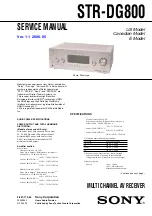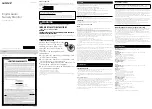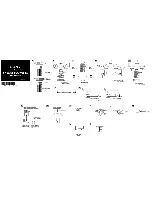
5
STR-DG800
SECTION 1
GENERAL
This section is extracted
from instruction manual.
US, CND model:
5
US
Getting Star
ted
Description and location of parts
To remove the cover
Press PUSH.
When you remove the cover, keep it out of
reach from children.
Getting Started
Front panel
?/1
AUTO CAL MIC
SPEAKERS
(OFF/A/B/A+B)
PHONES
MEMORY/
ENTER
CATEGORY
MODE
– CA
2CH
A.F.D.
MOVIE
MUSIC
MULTI CHANNEL DECODING
TUNING MODE
DISPLAY
INPUT MODE
TUNING
INPUT SELECTOR
ñ
+
TONE MODE
TONE
ñ
+
MULTI CH IN
DIRECT
MASTER VOLUME
VIDEO 3 IN/PORTABLE AV IN
VIDEO
L AUDIO R
DIGITAL(OPT)
PUSH
1
7
8
q;
3
5
qa
9
qd
qf
wf
qg
qh
ql
ws
wd
qj
wa w;
qk
2
4
6
qs
Name
Function
A
?
/
1
Press to turn the receiver
on or off (page 33, 42, 43,
67, 98).
B
SPEAKERS
(OFF/A/B/A+B)
Press to select OFF, A, B,
A+B of the front speakers
(page 35).
C
TONE MODE
Press to select Equalizer
mode (page 47).
D
TONE +/–
Turn to adjust the
EQUALIZER menu
parameters (page 47, 52).
E
TUNING MODE
Press to select the tuning
mode (page 71, 98).
F
/–
Turn to scan a station
(page 68, 70).
continued
6
US
G
Display
The current status of the
selected component or a
list of selectable items
appears here (page 7).
H
MULTI
CHANNEL
DECODING
lamp
Lights up when multi
channel audio is decoded
(page 43).
I
Remote sensor
Receives signals from
remote commander.
J
DISPLAY
Press to select information
displayed on the display
(page 82).
K
INPUT MODE
Press to select the input
mode when the same
components are connected
to both digital and analog
jacks (page 78).
L
MASTER
VOLUME
Turn to adjust the volume
level of all speakers at the
same time (page 39, 40,
42, 43).
M
DIRECT
Press to listen to high
quality analog sound
(page 66).
N
MULTI CH IN
Press to select the audio
directly from the
components connected to
the MULTI CH IN jacks
(page 40).
O
INPUT
SELECTOR
Turn to select the input
source to playback (page
40, 42, 43, 66, 68, 71, 78,
82, 83).
P
MOVIE,
MUSIC
Press to select sound fields
for movie or music (page
63).
Q
A.F.D.
Press to select A.F.D.
mode (page 61).
R
2CH
Press to select 2CH
STEREO mode (page 66,
67).
Name
Function
Name
Function
S
CA/–
Press to select a category
(page 75).
T
CATEGORY
MODE
Press to select the
category mode (page 74).
U
MEMORY/
ENTER
Press to store a station or
enter the selection when
selecting the settings
(page 33).
V
VIDEO 3 IN/
PORTABLE AV
IN jacks
To connect a camcorder or
video game (page 29, 40).
W
PHONES jack
Connects to a headphone
(page 94).
X
AUTO CAL MIC
jack
Connects to the supplied
ECM-AC2 optimizer
microphone for the Auto
Calibration function (page
35).
7
US
Getting Star
ted
About the indicators on the display
L
C
R
SL
SW
S
SR
SBR
SBL SB
LFE
SLEEP MULTI CH IN
SP.A SP.B A.DIRECT HDMI EQ D.RANGE
DTS-ES
CAT OPT COAX MONO
MEMORY
;
PL IIx
96/24 NEO:6
D.ASSIGN STEREO
;
DIGITAL EX
wa
qf
qg
w;
ql
qk
qj
qh
1 2
3
4
5 6
7
8
9
q; qa qs
qd
Name
Function
A
SW
Lights up when sub woofer
selection is set to “YES” (page
49) and the audio signal is
output from the SUB WOOFER
jack.
B
LFE
Lights up when the disc being
played back contains an LFE
(Low Frequency Effect)
channel and the LFE channel
signal is actually being
reproduced.
C
SP.A/SP.B
Lights up according to the
speaker system used. However,
these indicators do not light up
if the speaker output is turned
off or if a headphone is
connected.
D
A.DIRECT
Lights up when ANALOG
DIRECT is selected (page 66).
E
HDMI
Flashes when you select
“HDMI V. ASSIGN” in the
Video menu (page 81).
F
EQ
Lights up when the equalizer is
activated (page 47).
G
D.RANGE
Lights up when dynamic range
compression is activated (page
47).
H
;
DIGITAL
(EX)
Lights up when Dolby Digital
signals are input. “
;
DIGITAL EX” lights up when
Dolby Digital Surround EX
signals are decoded.
Note
When playing a Dolby Digital
format disc, be sure that you
have made digital connections
and that INPUT MODE is not
set to “ANALOG FIXED”
(page 78).
I
DTS (-ES)/
(96/24)
Lights up when DTS signals are
input. “DTS-ES” lights up
when DTS-ES signals are input.
“DTS 96/24” lights up when the
receiver is decoding DTS 96
kHz/24 bit signals.
Note
When playing a DTS format
disc, be sure that you have made
digital connections and that
INPUT MODE is not set to
“ANALOG FIXED” (page 78).
J
CAT
Lights up when you select
category mode to “ONE CAT”.
For details on presetting XM
Radio station,
see page 76.
K
OPT
Lights up when INPUT MODE
is set to “AUTO 2CH” and the
source signal is a digital signal
being input through the
OPTICAL jack, or when
INPUT MODE is set to “OPT
FIXED” (page 78).
Name
Function
continued
8
US
L
COAX
Lights up when INPUT MODE
is set to “AUTO 2CH” and the
source signal is a digital signal
being input through the
COAXIAL jack, or when
INPUT MODE is set to “COAX
FIXED” (page 78).
M
MEMORY
Lights up when a memory
function, such as Preset
Memory (page 70), etc., is
activated.
N
Preset
station
indicators
Lights up when using the
receiver to tune in radio stations
you have preset. For details on
presetting radio stations, see
page 69.
O
Tuner
indicators
Lights up when using the
receiver to tune in radio stations
(page 67), etc.
P
D.ASSIGN
Lights up when the digital
assign function is used for
selected input.
Q
NEO:6
Lights up when DTS Neo:6
Cinema/Music decoder is
activated (page 62).
R
;
PL (II)/(IIx)
Lights up when the receiver
applies Pro Logic processing to
2 channel signals in order to
output the center and surround
channel signals. “
;
PL II”
lights up when the Pro Logic II
Movie/Music/Game decoder is
activated.
“
;
PL IIx” lights up when the
Pro Logic IIx Movie/Music/
Game decoder is activated.
However, these indicators do
not light up if both the center
and surround speakers are set to
“NO” (page 49) and you select a
sound field using the A.F.D.
button.
Note
Dolby Pro Logic IIx decoding
does not function for DTS
format signals or for signals
with a sampling frequency of
more than 48 kHz.
S
MULTI CH IN
Lights up when MULTI CH IN
is selected (page 40).
T
SLEEP
Lights up when the sleep timer
is activated (page 83).
Name
Function
U
Playback
channel
indicators
L
R
C
SL
SR
S
SBL
SBR
SB
The letters (L, C, R, etc.)
indicate the channels being
played back. The boxes around
the letters vary to show how the
receiver downmixes the source
sound (based on the speaker
settings).
Front Left
Front Right
Center (monaural)
Surround Left
Surround Right
Surround (monaural or the
surround components obtained
by Pro Logic processing)
Surround back left
Surround back right
Surround back (the surround
back components obtained by
6.1 channel decoding)
Example:
Recording format (Front/
Surround): 3/2.1
Output channel: When surround
speaker is set to “NO” (page 49)
Sound Field: A.F.D. AUTO
Name
Function
L
SW
C
R
SL
SR






































